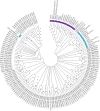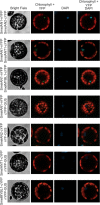Identification of a new R3 MYB type repressor and functional characterization of the members of the MBW transcriptional complex involved in anthocyanin biosynthesis in eggplant (S. melongena L.)
- PMID: 32407419
- PMCID: PMC7224497
- DOI: 10.1371/journal.pone.0232986
Identification of a new R3 MYB type repressor and functional characterization of the members of the MBW transcriptional complex involved in anthocyanin biosynthesis in eggplant (S. melongena L.)
Erratum in
-
Correction: Identification of a new R3 MYB type repressor and functional characterization of the members of the MBW transcriptional complex involved in anthocyanin biosynthesis in eggplant (S. melongena L.).PLoS One. 2020 Jun 17;15(6):e0235081. doi: 10.1371/journal.pone.0235081. eCollection 2020. PLoS One. 2020. PMID: 32555699 Free PMC article.
Abstract
Here we focus on the highly conserved MYB-bHLH-WD repeat (MBW) transcriptional complex model in eggplant, which is pivotal in the transcriptional regulation of the anthocyanin biosynthetic pathway. Through a genome-wide approach performed on the recently released Eggplant Genome (cv. 67/3) previously identified, and reconfirmed by us, members belonging to the MBW complex (SmelANT1, SmelAN2, SmelJAF13, SmelAN1) were functionally characterized. Furthermore, a regulatory R3 MYB type repressor (SmelMYBL1), never reported before, was identified and characterized as well. Through a qPCR approach, we revealed specific transcriptional patterns of candidate genes in different plant tissue/organs at two stages of fruit development. Two strategies were adopted for investigating the interactions of bHLH partners (SmelAN1, SmelJAF13) with MYB counterparts (SmelANT1, SmelAN2 and SmelMYBL1): Yeast Two Hybrid (Y2H) and Bimolecular Fluorescent Complementation (BiFC) in A. thaliana mesophylls protoplast. Agro-infiltration experiments highlighted that N. benthamiana leaves transiently expressing SmelANT1 and SmelAN2 showed an anthocyanin-pigmented phenotype, while their co-expression with SmelMYBL1 prevented anthocyanin accumulation. Our results suggest that SmelMYBL1 may inhibits the MBW complex via the competition with MYB activators for bHLH binding site, although this hypothesis requires further elucidation.
Conflict of interest statement
The authors have declared that no competing interests exist.
Figures








References
-
- D’Amelia V, Aversano R, Chiaiese P, Carputo D. The antioxidant properties of plant flavonoids: their exploitation by molecular plant breeding. Phytochemistry Reviews. 2018. 10.1007/s11101-018-9568-y - DOI

